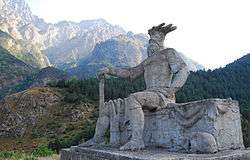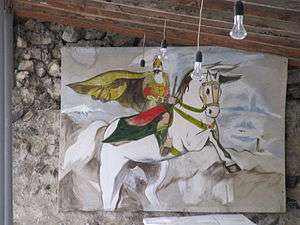Ætsæg Din

| Part of a series on |
| Neopaganism |
|---|
|
Related systems |
|
Similar movements |
|
Overarching organisations |

Ætsæg Din or Etseg Din (Ossetian: Æцæг Дин, literally "Exact Faith", "Right Faith")[1][2] is the modern organised revival of Ossetian ethnic religion (see Ossetian mythology), emerging since the 1980s.[3]
The Ossetians are an Eastern Iranic people of Alan-Scythian stock inhabiting a homeland in the Caucasus, now split between two states: the republic of North Ossetia–Alania within Russia, and the neighbouring, partly recognised state of South Ossetia (within Georgia).
In the Ossetian case, certain traditions of folk religion had survived with unbroken continuity, and were revived in rural areas. This contrasts, and interacts, with an urban and more intellectual movement which elaborated a systematic revival religion to overcome the crisis of identity of the Ossetian people, based in ethnic nationalism and opposition to both Russian and Georgian Orthodox Christianity, perceived as foreign, as well as the Islam professed by the neighboring Turkic and Caucasian ethnic groups and among a small minority of Ossetians. [3]
The Etseg Din movement is active both in North and South Ossetia. Whilst there are no figures about religious demographics for South Ossetia, in North Ossetia–Alania about 29% of the population adheres ethnic or folk religion according to 2012 survey statistics.[4]
Etymology
Ætsæg literally means "exact", "true" in the Ossetian language, a cognate of Avestan asha/arta, literally "truth", but also denoting "order", "divine law".
Din is a cognate of the Avestan Daena (whence din in Persian), which represents "insight" and "revelation", and from this "conscience" and "religion".
Official recognition
There are attempts to turn local traditional gods into objects of national worship in North Ossetia–Alania. For example, in former times, a grove was devoted to the local communal god/saint Khetag. After the clashes between Ossetians and Georgians in 1991-92, a glade near the wood was turned into a place for pan-Ossetian worship, including religious and political rituals, with activities supervised by the Great Council (Styr-nykhas), a non-governmental committee established in 1993.[5] The Khetag celebration was approved by the 1990s president of North Ossetia–Alania as a national holiday. A special foundation was established in order to raise funds for the reconstruction of the site, and since 1994 a big annual sacrifice is arranged at the Khetag shrine.[5]
See also
- Baltic neopaganism
- Caucasian neopaganism
- Scythian mythology
- Slavic neopaganism
- Uralic neopaganism
- Vattisen Yaly
References
- ↑ South Ossetia website. The Official Religions of South Ossetia. Retrieved 2013-07-31
- ↑ Местная религиозная организация традиционных верований осетин «Æцæг Дин»
- 1 2 V. A. Schnirelmann. "“Christians! Go home”: A Revival of Neo-Paganism between the Baltic Sea and Transcaucasia". Journal of Contemporary Religion, Vol. 17, No. 2, 2002.
"Since the turn of the 1980s, a growth of Neo-Paganism has been observed in
the Middle Volga region, in North Ossetia-Alaniia, and in Abkhazia. Pagan
traditions had never disappeared there completely and, in contrast to the Slavic
and Baltic regions, there was no need to invent too much by reference to books,
as almost all the resources were intact there. Thus, in these regions, interest in
Paganism developed in two different environments: firstly, in the countryside
with its unbroken continuity of traditional folk beliefs, and secondly, in the
urbanized areas where local, highly secularized intellectuals began to construct
a new synthetic religion in order to overcome a crisis of identity. In the latter
case, this was a manifestation of local ethnic nationalism resisting Russian
Orthodoxy as a ‘religion of exploiters’ (Filatov & Shipkov, 1996).
A special situation has emerged in Abkhazia where the religious situation" (p. 202).
"Contemporary Neo-Paganism is constituted by two different branches—one of a ‘bookish’ approach which is artificially cultivated by urbanized intellectuals who have lost their links with folk tradition, and the other, more authentic, is of a rural movement based on a continuity rooted in the remote past. The first dominates among the Russians, Ukrainians, Belorussians, Lithuanians, Latvians, and Armenians and can be defined as an ‘invention of tradition’, after Eric Hobsbawm (1983). A more complex pattern can be observed among the ethnic groups of the Middle Volga River region as well as among the Ossetians and Abkhazians, where both tendencies are interacting with one another." (p. 207) - ↑ Arena - Atlas of Religions and Nationalities in Russia. Sreda.org; 29% "adhere to a traditional religion of their ancestors, worship gods and the forces of nature". (исповедую традиционную религию своих предковпоклоняюсь богам и силам природы). This figure compares to 1.2% folk religionists in all of the Russian Federation, and in North Ossetia-Alania to 41% Russian Orthodox, 4% other Christian and 21% expressing "belief in God" without more specific designation of religious adherence.
- 1 2 Schnirelmann (2002) pp. 204-205, citing Popov (1995, pp. 62-67) and Dzeranov (1996).
Bibliography
- Schnirelmann, Victor: "“Christians! Go home”: A Revival of Neo-Paganism between the Baltic Sea and Transcaucasia". Journal of Contemporary Religion, Vol. 17, No. 2, 2002.
- Shtyrkov, Sergey: Religious nationalism in contemporary Russia: the case of the Ossetian ethnic religious project // Understanding Russianness (Routledge Advances in Sociology). Ed. by Risto Alapuro, Arto Mustajoki, Pekka Pesonen. London: Routledge. 2011. P. 232-244.
- Filatov, S. & Shchipkov, A. Povolzhskie narody v poiskakh natsional’noi very. In Filatov, S. B., ed. Religiia i prava cheloveka: Na puti k svobode sovesti. Moscow: Nauka, 1996: 256–284.
- Dzeranov, T. E. Vliianie gosudarstvennykh form religii na dukhovnuiu kul’turu osetin i prichiny sokhraneniia yazycheskikh verovanii v Osetii. Paper presented at the Meeting of the Scientic Board of the Russian Museums on Problemy etnokul’turnoi istorii regiona i ikh muzeinaia interpretatsiia in Stavropol’, 27–31 May 1996.
- Popov, K. P. Sviashchennaia roshcha Khetaga. Vladikavkaz: Ir, 1995.